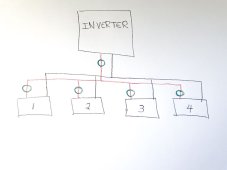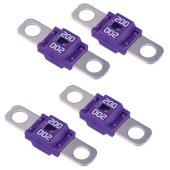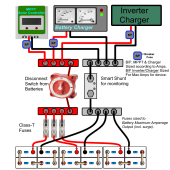JWLV
-.-. --.-
- Joined
- May 27, 2020
- Messages
- 579
I'm in the process of putting together four 24V 200A LiFePo4 batteries in parallel.
I have some questions about fuses.
See this diagram.

The batteries are labeled 1-4. The green circles are where the fuses will go. I know that a fuse is needed at each battery. What about a fuse at the inverter? Or will a circuit breaker switch be adviseable there? Or both?
The inverter is 3000W. So I am planning to use 200A fuses, like this one on Amazon: https://www.amazon.com/Current-Trucks-Construction-Vehicles-Caravans/dp/B0BZVR7V5W

Is this the right type of fuse? Is 200A the proper size for this system?
I prefer bolt-down fuses so that I won't have to get more cables.
I have some questions about fuses.
See this diagram.

The batteries are labeled 1-4. The green circles are where the fuses will go. I know that a fuse is needed at each battery. What about a fuse at the inverter? Or will a circuit breaker switch be adviseable there? Or both?
The inverter is 3000W. So I am planning to use 200A fuses, like this one on Amazon: https://www.amazon.com/Current-Trucks-Construction-Vehicles-Caravans/dp/B0BZVR7V5W

Is this the right type of fuse? Is 200A the proper size for this system?
I prefer bolt-down fuses so that I won't have to get more cables.





